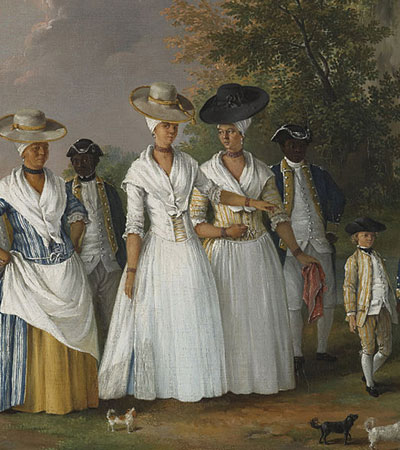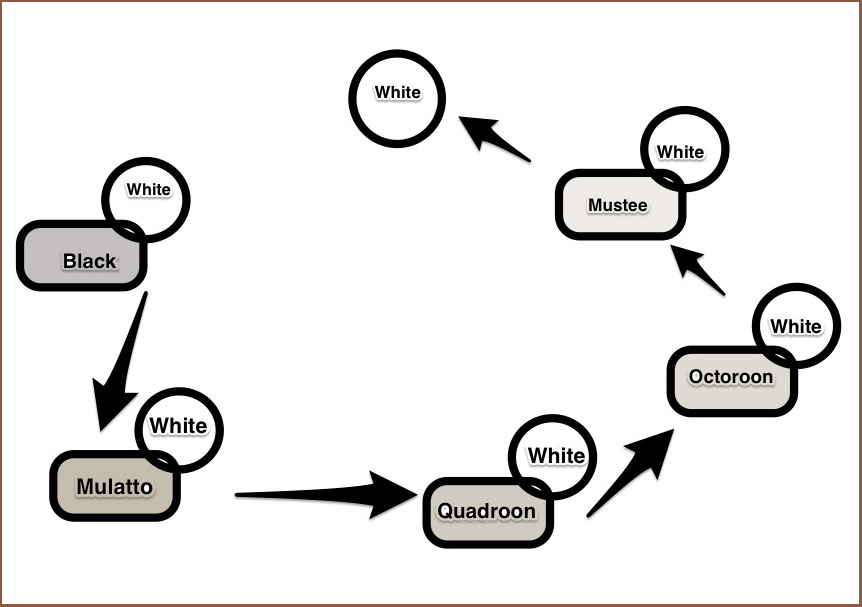Free Women of Color ~ Agostino Brunias
In the 1780s, French traveler Moreau de St. Méry documented eleven different racial combinations in French-controlled Saint-Domingue. Then, taking into account the interracial mingling over a span of several generations, he sub-categorized more than a hundred variations.
To say his resulting table is expansive is an understatement.1
Moreau’s work was an early attempt at formulating a science of skin color and, taken in context, it illustrates the obsessive race to white in the European-dominated West Indies.
Similarly, contemporary historian Edward Long expanded on the colonial preoccupation with skin tones in his History of Jamaica.
Degrees of Distinction
Long claimed Spanish colonists thought it worthwhile to “mend the breed by ascending or growing whiter; insomuch that a Quateron will hardly keep company with a Mulatto; and a Mestize values himself very highly in comparison with a Sambo.”2
As for the Dutch, Long wrote, they transcended the Spaniards “very far in their refinement of these complexions.” Their approach to the science of skin color included adding drops of clear water to a “single drop of dusky liquor, until it becomes tolerably pellucid.”3
As crazy as that sounds, Long may have actually tried the ludicrous experiment. He reported that when using the analogy as many as thirty generations might not be “sufficient to discharge” the dusky “stain.”4
But the British Jamaicans weren’t as obsessive, according to Long. The ancestral distinctions common in Jamaican records were mulatto, quadroon, octoroon, and mustee. Often, Jamaicans simply used the word “mulatto.”
The Race to White in 18th-century Jamaica ~ LLG
Nevertheless, regardless of the degree of distinction, the distinctions were crucial—to creoles of European and African ancestry both. Miscegenation had resulted in generations of children of varying ancestry and skin tone, and skin color had come to dictate legal, social, and economic status throughout the Americas.
The closer one’s skin tone to white, the better one’s status.
Sex An Unwritten Colonial Right
Most planters considered copulation with their female slaves their right, and the practice was openly tolerated in the West Indies. As a result, It led to a “vast addition of spurious offsprings of different complexions,” producing a “tawney breed.”5
Long explained it thus:
“A place where, by custom, so little restraint is laid on the passions . . . men, of every rank, quality, and degree here, who would much rather riot in their goatish embraces, than share the pure and lawful bliss derived from matrimonial, mutual love. Modesty, in this respect, has but little footing here. He who should presume to shew any displeasure against such a thing as simple fornication, would for his pains be accounted a simple blockhead; since not one in twenty can be persuaded that there is either sin; or shame in cohabiting with his slave.”6
The 18th-Century West Indies Creole

A creole was a nonindigenous island born person, regardless of his or her skin tone or ancestry. Moreover, there were three classes of creoles.
White Creoles
First were the white creoles. White creoles were born into privilege. Free, they enjoyed some control over their fate and—subject to property and religious qualifications—entitlement to civil rights. Even those born destitute had the opportunity to better their economic status.
Black Creoles
Second were the black creoles, those of African descent. The vast majority of black creoles were born enslaved. The enslaved had no civil rights. They were subject to a harsh criminal code and had little or no opportunity to better their economic status.
The Barbadoes Mulatto Girl ~ Agostino Brunias
Brown Creoles
Lastly were the brown creoles—creoles of mixed ancestry. Their rights fell somewhere in between, and each colonial power had its own set of laws.
If classed a mulatto, an enslaved creole was usually accorded a superior social rank in the slave community. The trace of European ancestry generally granted the enslaved domestic labor as opposed to field labor. Often a mulatto was given the chance to learn a trade, and with a trade came the opportunity to earn money in one’s free time.
The more fortunate mulatto might even attain his or her freedom. On more than one occasion a slave owner manumitted (freed) both his mixed-ancestry children and their mother.
Slavery’s Cruelest Legacy
Until the color of a man’s skin is of no more significance than the color of his eyes, me say war . . .” Lyrics to Bob Marley’s “War”
Fortunately, the laws have changed. Now, though we still label (i.e. African-American), the label “mulatto” has fallen from common use in America.
Still, given the history, it’s easy to understand any lingering preference for light skin tones. Generations of children grew up believing they were a white man’s property, powerless chattel because of their African ancestry and inherent skin tone.
How many generations will it take to discharge that stain from the psyche?
“Do you remember meeting Mrs. Paterson and Miss Hart at dinner, Mr. Brock?” Miss Airth asked. “Quaminah says they’re brown girls, not white. Tell him, Quaminah.”
Swallowing a sigh, Liam scratched his chin. If he let the conversation continue, Quaminah would soon cite the ideal width and angle of a girl’s nose and lips. Rose tarried with the same preoccupation.
The journey from black to white or white to black was complex at best. ~ Voices Echo
1 Moreau de St Mery, Description Topographique, Physique, Civile, Politique et Historique de La Partie Francaise de L’isle Saint-Domingue. : Avec Des Observations Générales Sur La Population, Sur Le Caractère & Les Moeurs de Ses Divers Habitans; Sur Son Climat, Sa Culture, Ses Productions, Son Administration, &c. &c. Accompagnées Des Détails Les plus Propres à Faire Connâitre L’état de Cette Colonie à L’époque Du 18 Octobre 1789; et D’une Nouvelle Carte de La Totalité de L’isle., vol. 1, 2 vols., 1797, https://archive.org/details/descriptiontopog00more. 71
2 Edward Long, The History of Jamaica: Or, General Survey of the Antient and Modern State of That Island, With Reflections on Its Situation, Settlements, Inhabitants, Climate, Products, Commerce … Vol. 2, facs, Cambridge Library Collection (Cambridge: Cambridge Univ. Press, 2010). 261
3 Ibid., 261
4 Ibid., 261
5 Ibid., 328
6 Ibid., 328








You should write a book about my family The Yates Family 1700-1800’s quadroons that owned Port Royal which was a big part of the slave trade I believe… Google Ambrose Nicolas Yates (Cramer by birth) which is Irish by way of South Ireland (Cork) from my history Ambrose first child which was his son Ballard James Yates born 1/14/1816 (the first Quadroon) his mother was a women A. Ezekiel.
I’ll look into Terrell!